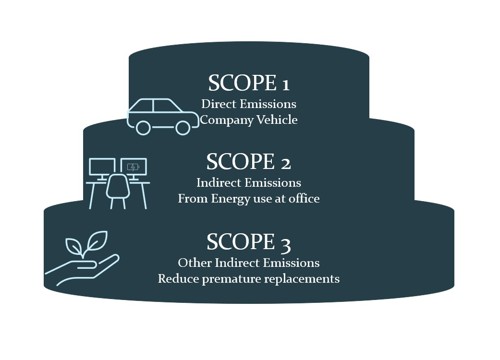E Our Environmental Commitment
Although we are not legally required to publish ESG reports, we believe it makes sense to be transparent about how we think and act on sustainability.
That’s why we’ve chosen to share our perspective, particularly on emissions, and how our work contributes to reducing environmental impact.
At Nordic Glasfiber, our footprint is small, but the impact we help create is meaningful.
Our environmental responsibility comes not from what we produce, but from how we help others reduce what they waste. Through inspections that extend the life of industrial fiberglass equipment, we support smarter use of resources, fewer premature replacements, and lower emissions throughout the value chain.
Read more below about our approach to Scope 1, 2 and 3 emissions, and where we believe we can make the biggest difference.

Environmental
Our Scope 1,2,3 in short
At Nordic Glasfiber, our environmental responsibility lies not only in reducing our own emissions but in empowering others to do the same.
Scope 1 Direct Emissions
Our direct emissions are limited, primarily originating from the use of company vehicles during site inspections and client meetings. We continuously seek to minimize this impact by optimizing travel routes and exploring lower-emission vehicle options.
Scope 2 Indirect Emissions from Energy
These emissions result from the energy consumed at our office facilitie. We actively promote responsible energy use among our team to minimize this footprint.
Scope 3 Other Indirect Emissions
This is where we have the most significant environmental footprint, but also the greatest opportunity to contribute to sustainability. By carrying out detailed inspections and condition assessments of industrial fiberglass equipment, we help our clients extend the service life of their assets. This leads to fewer replacements, less industrial waste, and reduced emissions from manufacturing new components.
Through our partnership with UTComp and the use of UltraAnalytix® technology, we offer non-destructive, data-driven assessments. These enable informed decision-making while promoting the efficient use of resources, a key factor in long-term environmental management.

